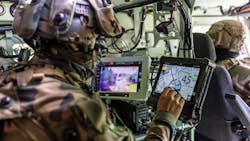STR moves to advanced development in DARPA project to develop battle management software and communications
ARLINGTON, Va. – Battle management experts at Systems and Technology Research LLC (STR) in Woburn, Mass., are moving forward with a project to develop software to boost the effectiveness of large-scale military planning through theater-scale command and control with automation and predictive analytics.
Officials of the U.S. Defense Advanced Research Projects Agency (DARPA) in Arlington, Va., announced a $27.9 million completion contract to STR on Thursday for phase three of the Joint All-Domain Warfighting Software (JAWS) program.
JAWS considers dynamic coordination of kill webs across the battlespace, since sensors, weapons, and decision makers are not always in the same place.
This approach to command and control enables flexibility by enabling decision makers to optimize assignments by developing software to set up synchronized kill webs that operate on and under the sea, on land, in the air, in space, and in the electromagnetic spectrum.
Phase three will build on and extend the orchestration services, predictive analytics, and user interfaces developed during the first two program phases.
The order brings the total value of the contract to $58.1 million. STR won a $15.2 initial contract in December 2020 for the DARPA JAWS program, and won a $15 million order in March 2022 for the program's first and second phases. The Raytheon Technologies Corp. Missiles & Defense and Intelligence & Space segments also has been JAWS contractors.
The primary issues for command and control are sensing, communications, and weapons. JAWS defines sensing is the ability to detect, geolocate, and identify potential targets for attack.
Communications is the ability to pass data at the right time and quickly enough to deploy, maintain, and maneuver, assets. Weapons involves choosing the right weapon for the job.
Coordinating kill webs in areas as large as military theaters typically are centralized and difficult to scale. This can result in flexibility at low military echelons, but in cumbersome human-intensive planning at high echelons, with widespread use of tactical radios with targeting information.
Instead, the JAWS program seeks to develop the software tools that create a distributed command and control structure using dynamic teaming and machine-to-machine interfaces to enable centralized and distributed planning and execution combinations.
For example, when few targets and resources are involved, much of the overall battlespace can push to the tactical edge without significant coordination. Yet with many targets over large areas, theater level coordination is necessary to allocate resources efficiently.
JAWS is not intended to prescribe command structures but enable them based on mission need; it is inherently a man-machine team. The tools developed in JAWS should support the speeds necessary to decision makers to synchronize kill webs at scale.
The intended users of JAWS are the joint force commanders working across military services and warfare domains. Select command and control forces at the tactical edge will interface with JAWS for tight coordination.
The JAWS program should yield new capabilities that include:
-- extendable architectures that abstract essential resource and tasking data dependencies for rapid integration of new sensors, communication concepts, and weapon systems;
-- ways to abstract and resolve sequences of events like coordinated fires with variable planning horizons; and
-- ways to safeguard warfighting capability amid intermittent or permanent loss of information flow between any nodes.
DARPA researchers want to demonstrate solutions in a live, virtual, constructive environment to consider various scenarios and evaluate command and control features. This virtual environment will call for four rackmount computer servers with 500 gigabytes of memory, 100 cores on CPU; and one terabyte of solid-state data storage.
The test environment also will have 500 terabytes of network-attached data storage; and five desktop workstations with 10-core CPUs, and 256 gigabytes of memory, one terabyte of disk storage.
On this order STR will do the work in Woburn, Malden, Tewksbury, and Brewster, Mass; Poway, Calif.; Fairfax, Va.; and Churchville, Md.; and Arlington, Texas, and should be finished by August 2024.
For more information contact STR online at www.str.us, Raytheon Technologies Corp. at www.rtx.com, or DARPA at www.darpa.mil.
About the Author
John Keller
Editor-in-Chief
John Keller is the Editor-in-Chief, Military & Aerospace Electronics Magazine--provides extensive coverage and analysis of enabling electronics and optoelectronic technologies in military, space and commercial aviation applications. John has been a member of the Military & Aerospace Electronics staff since 1989 and chief editor since 1995.
